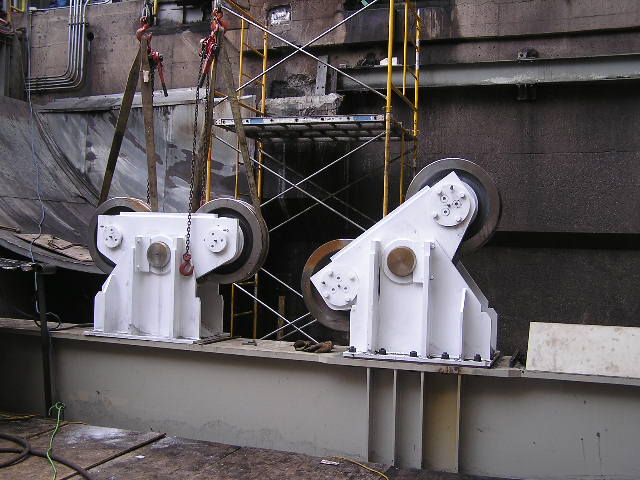The support trunnions are the foundation on which a car dumper is built. They frequently don’t get the attention they deserve as they operate in an often hard to reach and dirty environment but failure to do so could lead to bigger issues down the road.
Common Problems
Wear
- As the rollers and end ring rails wear, the dumper sits lower in the pit such that the platform / platen rails are no longer aligned to the corresponding land mounted rails. This leads to greater roll on and roll off loads of the rolling stock which generates undesired impact loads and stresses into the dumper cage. This can lead to premature failure of the trunnion bearings and development of fatigue cracks in the dumper structure.
- Excessive wear on the thrust faces of the flanged rollers indicates that there is some misalignment and that the dumper cage is thrusting along the axis of the platform / platen rails. The end rings and end ring rails are experiencing equivalent thrust loads which can lead to cracking of the end rings and dumper cage as well as other problems.
Alignment / Thrusting
- The alignment can also change due to movement of the trunnion rollers, whether that be from a single incidence or gradually over time from rolling stock entering and leaving the dumper or foundation settlement. In such a scenario, the trunnions will no longer be parallel to each other leading to ‘corkscrewing’ of the dumper cage. Under these circumstances, the dumper cage wants to thrust in one direction or the other parallel to the track rails. This creates unwanted stresses in the cage that reduce the dumper operating life and increases wear on the trunnions and end ring rails. In severe cases, the dumper cage can thrust into the land mounted thrust pads with the potential for considerable damage.
- Misalignment can also lead to problems at the pinion and gear rack as proper meshing of the teeth is no longer assured. The center distance can change such that the rack can potentially bottom out (or even come out of the mesh completely) and the contact area can be significantly reduced such that there is an overload. Ultimately, this will lead to premature wear of the pinion and rack and potentially tooth cracking or breakage.
Lubrication
- Proper lubrication is important. Lack of lubrication leads to premature bearing failure and occasionally catastrophic damage. In many cases, the grease is not only a lubricant but is also a barrier seal to prevent dirt or material from getting into the bearing. Foreign material entering your bearings can damage them in a very short amount of time.
- Too much lubrication builds pressure within the bearing. The increased friction and pressure from too much grease raises the temperature and can decrease the effectiveness of the lubricant. It can even cause the oil to separate from the thickener. This leads to decreased bearing life and consequently, a shorter period between major shutdowns.
Recommended Approach
Inspection
It’s good practice to set up a monthly inspection routine for your trunnions.


